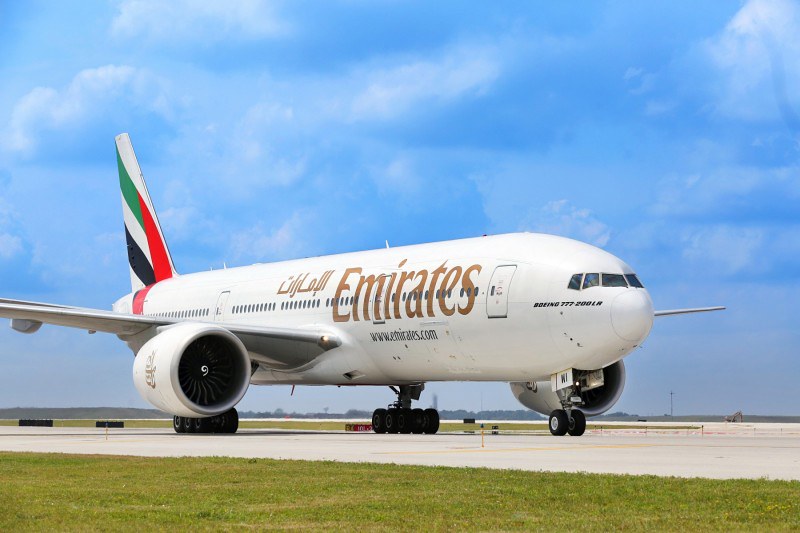Emirates Airline made waves at the opening of the Dubai Airshow today by announcing a gargantuan new order for Boeing aircraft worth $52 billion. The airline, owned by the United Arab Emirates (UAE), signed agreements to purchase 50 Boeing 777X jets along with 35 Boeing 787 Dreamliners.
The bumper deal from one of Boeing’s biggest customers provides a major boost for the US airplane manufacturer amid a slowing global economy. It also portrays Emirates’ continued ambition to expand its fleet and routes.
Boeing Sale Bolsters 777X Program and Ownership Base
The centerpiece of Emirates’ order consists of 90 of Boeing’s latest generation 777X jets, split between the 2 variants, with 35 777-8s and 55 777-9. The 777X models are larger and more efficient versions of Emirates’ existing 777s.
When combined with Emirates’ previous 777X commitments, the new deal brings its total order book for the plane to 205 units. According to Boeing, this cements Emirates as the largest operator of 777 aircraft in the world.
Emirates is expected to receive the first deliveries of the 777-9 in 2025. The order sets the airline up to receive new 777-9s through 2035 as well. It will also make Emirates one of the first customers to operate the 777-8 variant, with the initial units arriving in 2030.
The sale provides a boost to Boeing’s 777X program, which has faced delays and uncertain demand amid the pandemic and airplane production issues. Emirates’ decision to throw its weight behind the new model with such a large order effectively restores confidence in the 777X’s future.
“We’ve been closely involved in the 777 program since its start up until this latest generation of 777X aircraft. The 777 has been central to Emirates’ fleet and network strategy of connecting cities on all continents non-stop to Dubai. We are pleased to extend our relationship with Boeing and look forward to the first 777-9 joining our fleet in 2025”, said the Chairman and Chief Executive of the Emirates Airline and Group, HH Sheikh Ahmed bin Saeed Al Maktoum.
More Dreamliners for Long-Haul Growth
In addition to the 90 777Xs, Emirates also purchased 5 787 Dreamliners. This adds to Emirates’ previous commitments to the model and boosts its order book to 35.
Emirates notes that the Dreamliner purchase will also include replacements for aircraft that will be retired. It will help the airline sustain its future long-haul growth.
Boeing says that its 787 models deliver superior fuel efficiency and passenger comfort for long-range flights. For Emirates, the lightweight composite 787 provides added flexibility to complement its larger 777s.
Also read: The Top 40 Airlines: Who is The Star on Social Media?
With bases in Dubai and global passenger demand rebounding, Emirates continues to build up capacity to connect travelers across its worldwide network. Both the 777X and 787 give Emirates new options for serving far-flung destinations.
News of the huge aircraft transaction came on day one of the biennial Dubai Airshow. Emirates executives signed the deal at the airshow’s opening press conference.
Emirates seems to have timed the announcement to make a splash as business aviation leaders gathered in its hometown. By flexing its purchasing power on home turf, Emirates and its parent company FlyDubai are showcasing their ambition to keep transforming Dubai into a global transit hub.
For Boeing, the agreement provides a valuable addition to its order book after a period of struggles. The planemaker’s reputation has suffered tremendously from both the fatal 737 MAX crashes and its well-known production problems and the impact that the pandemic had on its schedules and order book. High-profile sales like the Emirates deal will help rebuild confidence in the manufacturer’s leading stand in this highly competitive industry.
Emirates Aims to Strengthen its Dominance in the Middle East
According to Boeing’s latest forecast, nearly half of the new commercial jets delivered to Middle Eastern carriers over the next 20 years will be wide-body models. This reflects the hub role played by regional airlines like Emirates.
With Dubai located at the crossroads of global travel, Emirates relies heavily on spacious, long-range aircraft like the 777 and 787. These widebodies allow it to transport travelers between distant population centers with minimal stops.
“This order is an incredible vote of confidence in Boeing’s highly efficient widebody family and the versatility of our 777X and 787 airplanes to meet Emirates’ needs for global long-haul travel”, commented Stan Deal, president and CEO of Boeing Commercial Airplanes.
Also read: Social Media Strategy Review: The Aviation Sector
By further expanding its fleet of twin-aisle jets, Emirates is doubling down on shuttling passengers through the busy Dubai hub. A long-lasting post-pandemic recovery of the global aviation industry and tourism will help drive the expected demand for these direct intercontinental connections.
At the same time, rising fuel costs make the enhanced efficiency of Boeing’s newest planes attractive. Airlines like Emirates need jets that can minimize fuel burn at a time when oil prices are climbing. The 777X and 787 families are designed to use 25% less fuel than older generation of wide-body planes.
Once the new aircraft begin entering service, Emirates says that its fleet could reach 350 jets in operation by the early 2030s. The airline currently has a fleet of around 250 aircraft.
Emirates still has nearly 200 additional planes on backlog that are unrelated to this latest mega-deal. And with this week’s purchase, Emirates locks in delivery slots for new 777Xs and Dreamliners to power its expansion well into the future.
Emirates and rival Gulf carriers have faced criticism in recent years for their aggressive growth plans. However, the accelerated recovery of global travel demand following the COVID-related disruptions may provide the opportunity for the business to absorb incoming passenger traffic to and from the region.
